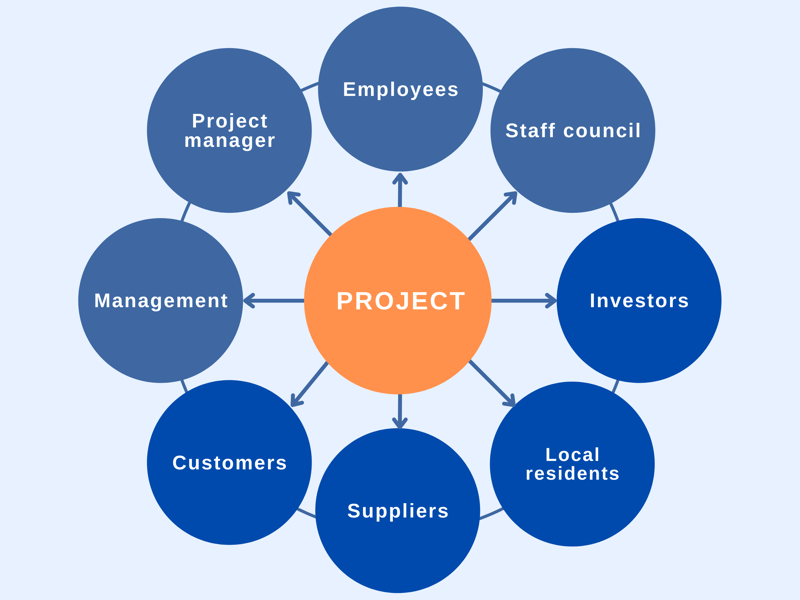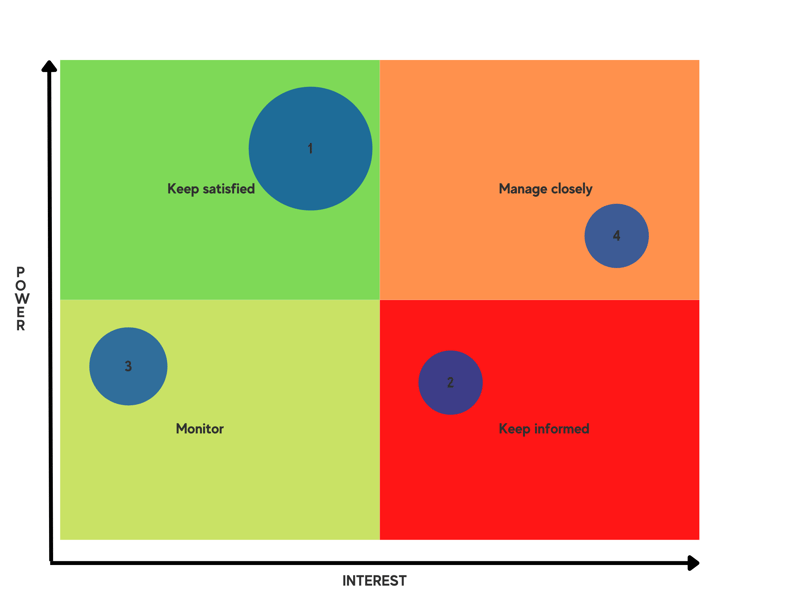Projects are constantly influenced by different people, either directly or indirectly. These groups are known as stakeholders.
Those who know what stakeholders want can move things along whereas critics can take the wind out of a project's sails. Whatever the case, performing a stakeholder analysis will show where everyone stands.
In this guide, we'll teach you how to perform a stakeholder analysis and tell you everything you need to pay attention to.
Stakeholder Analysis: Definition
The German Institute for Standardization's DIN 69901-5:2009 defines stakeholder analysis as "An assessment of all project participants concerning their influence upon the project and its positioning (positive or negative)."
Said differently, a stakeholder analysis is a systematic classification of all those interested in a project that's performed to anticipate their impact upon and reaction to decisions.
What Is a Stakeholder?
Stakeholders are those who have an interest in a particular project and can influence its course. These can be individuals or groups of people. Most of the time, a differentiation is made between internal and external stakeholders.
Internal Stakeholders
Internal stakeholders are those within a company, organization, or business. Some common internal stakeholders include:
Anyone who works on or is impacted by a project
Workers committees
Personnel boards
Project managers
Business managers or management
Legal, IT, or other departments
External Stakeholders
External stakeholders are those who aren't directly employed by the business or organization undertaking the project but are still impacted by it. This includes people, groups, or institutions, such as:
Customers
Suppliers
Investors
Shareholders
Unions
Organizations and associations
NGOs
Local government
Nearby residents

It's common to differentiate between internal and external stakeholders, as well as whether they influence a project directly or indirectly.
Purpose and Content of a Stakeholder Analysis
A stakeholder analysis helps to identify all of a project's stakeholders along with their requirements, needs, and desires. By understanding their opinions, you'll be able to determine who the supporters and detractors are.
Stakeholder analyses are essential for a business's long-term viability. Ignore them at your peril, since doing so can cause projects to fail.
At the same time, those who effectively use stakeholder analyses can sustainably improve their project's image. Simply interacting with stakeholders as part of an analysis can help them feel heard and included.
With that said, a stakeholder analysis only provides a snapshot. Positions can and do change frequently. This makes it sensible to regularly perform stakeholder analyses.
Who Is a Stakeholder Analysis For?
Stakeholder analyses apply to all kinds of projects. They're especially good for comprehensive construction or infrastructure undertakings. These projects have a lasting impact on nature, the environment, and people living nearby.
Should you neglect to perform a stakeholder analysis and suffer from poor communication, your project can be negatively impacted. In the worst case, it might fail.
Large businesses and concerns include stakeholder analyses in their sustainability reports. These analyses classify stakeholders and address their impacts on groups.
When to Perform a Stakeholder Analysis?
For many projects, a stakeholder analysis is only performed during the planning phase. It's better to consistently perform stakeholder analyses so that you can check the project's topicality, and adjust it if needed.
This is important since opinions and stances change over a project's course. In addition, mistaken conclusions or summations made at the beginning of a project can be corrected as it develops.
Performing a Stakeholder Analysis
A stakeholder analysis is a multi-step process, and typically consists of these steps:
- 1.
Identify the stakeholders
- 2.
Gather information about the stakeholders
- 3.
Evaluate the stakeholders and accompanying information
- 4.
Visualize the results
Identify the Stakeholders
To identify the relevant stakeholders, you'll need to be familiar with a project's timeframe and its most important milestones. Only then can you meaningfully interact with stakeholders.
A good place to start is by distinguishing between individuals and groups. The first should be identified by name and function (i.e. John Smith, data privacy coordinator).
For groups, it becomes somewhat more complicated to find the right contact person or opinion leader/shaper. If dealing with an organization or association, this can be easy, since these typically have hierarchical structures.
However, for informal groups, such as residents or concerned citizens, you might need to do additional research.
While core stakeholders are important, make sure that you consider the entire environment. To maintain an overview, note all stakeholders. If you identify a large number of stakeholders, you can group them by interest.
Gather Information About the Stakeholders
There are different ways to collect information for your stakeholder analysis. Some of the most common include:
Interviews
Workshops
Consultation of freely available information
It's advisable to start as early as possible with interviews and workshops. Conversations should be just that, and not seem like interrogations. Make sure that stakeholders feel heard and that they're being taken seriously.
Discussions should be structured, with ample opportunities for stakeholders to voice their wishes and hopes, as well as their criticism and fears.
The more open and meaningful the conversation, the better the results will be. Apart from that, every project management team can tailor the approach to their needs: Individual consultations, large Q&A sessions, or focus groups.
It is advisable to not invite groups with different interests to the same meeting. A better approach is to gather groups with similar interests and have them jointly voice their feelings and opinions.
In addition, interviews have an advantage over workshops in that you'll hear opinions from more introverted stakeholders who might be intimidated by large group settings.
Don't forget to record the conversation(s) or take extensive written notes to save the information you gather.
Apart from direct conversations, you can also use other sources of information, such as written reports from earlier projects. Public posts on social networks can also yield plenty of insight.
Evaluate the Stakeholders
As soon as you've identified the stakeholders and collected information about them, you can evaluate it with a matrix. To do this, input the following data:
Name of the person, department, or organization
Role, either generally or within the project
Type (individual, informal group, association, etc.)
Size and type of influence (organizational, social, subject-matter expertise, financial, legal)
Internal or external
Opinion (positive/supportive, neutral, negative/dismissive)
Strengths and weaknesses
Affiliation with special groups (union, state government, lobbies)
With this data, it becomes possible to see where conflicts might emerge and what sort of impact they can have. Determining which factors to include depends entirely on your project.
Some projects require the publication of a stakeholder analysis. In these cases, it's important that the analysis's wording doesn't reveal an individual or group's opinion or take any position on it.
Instead, stakeholder analyses intended for public consumption should use neutral language. If necessary, an external/public version of the analysis can be prepared.
Visualization of Stakeholder Analysis With a Stakeholder Map
To clearly and accurately present the analysis's results, visualize the stakeholders along with their relations and stances. This is easiest with a stakeholder map, also known as a power interest grid.
Stakeholders are depicted in the stakeholder map as circles, the size and position of which indicates their influence. Relations between stakeholders can also be shown on the stakeholder map.
You can group stakeholders into different categories to reflect their influence on the project:
Participative: Supports the project and has a high level of influence
Discursive: Supports the projects, but has little influence
Neutral: Is ambivalent regarding the project; neither supports or blocks it
Restrictive: Does not support the project and has a high degree of influence
Repressive: Does not support the project, but has little influence

You can visualize different interest groups with a stakeholder map.
Participative stakeholders should be actively involved in the project, since they support it and want it to succeed. They are important opinion formers during discussions and decision-making sessions.
Discursive stakeholders should also be taken just as seriously as participative stakeholders. However, owing to their limited influence, this group should be less involved in the project's development.
How you interact with restrictive stakeholders is particularly important. This group likely won't want to be involved in the project, since they don't support it.
At the same time, this isn't an excuse to ignore them! Attempts should be made to convince them of the project's virtues. In addition, keep them up to date about the project's progress.
For external presentations, make sure that your stakeholder map is anonymized.
Common Stakeholder Analysis Risks and Mistakes
Stakeholder analyses can help many projects achieve successful outcomes. However, they also have risks and if performed incorrectly, can negatively impact a project.
Inaccurate evaluation/assessment
Stakeholder opinions and positions are commonly misunderstood.The Halo effect, a cognitive bias, suggests that a person's future behavior or ability will be over-estimated based on past knowledge or familiarity with their work.
Person feelings, either positive or negative, can also lead to inaccurate evaluations. Since a stakeholder analysis is always performed by people, it can never be entirely objective.
Be aware of your biases and try not to let them influence your stakeholder analysis. To avoid this, always perform a stakeholder analysis as a team.
Information leaks
Sensitive data is collected whenever a stakeholder analysis is performed. This mostly relates to personal opinions and positions. Stakeholder analysis documents should always be handled carefully.Serious consequences can result if these documents are ever released publicly.
Setting the wrong priorities
Another mistake is setting the wrong priorities for stakeholders. This can happen when you inaccurately assess hierarchies or the influence of a person or group.For example, you might view someone as a major stakeholder who is a department head. However, in reality, they are barely involved in the project and only lead a team that contributes extensively.
Miscommunication and misunderstandings
Communication can also be improperly configured and not work as intended. If stakeholders with significant influence feel that they aren't being kept up to date, the project can lose key support.A desire to please everyone
It's important to accept every stakeholder's opinion and views. At the same time, do not try to please everyone. This is both impossible and more than likely to endanger the project.Stakeholder analysis is not factored into risk analysis
Insights gained from a stakeholder analysis should be part of the risk analysis. This is especially important for stakeholders with significant influence, either negative or positive.In this case, the stakeholder analysis helps to (hopefully) positively influence stakeholders.
Conclusion
A stakeholder analysis is an important component of any project's success. It starts by identifying internal and external stakeholders who are involved either directly or indirectly with the project, as well as their opinions.
A successful stakeholder analysis can help to focus project communication on stakeholders. Do your best to prevent sensitive information resulting from the analysis from being published.












